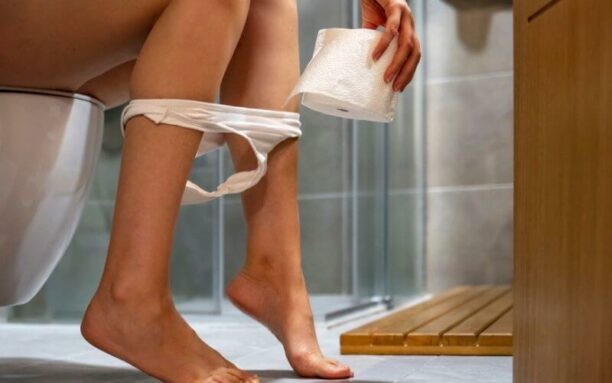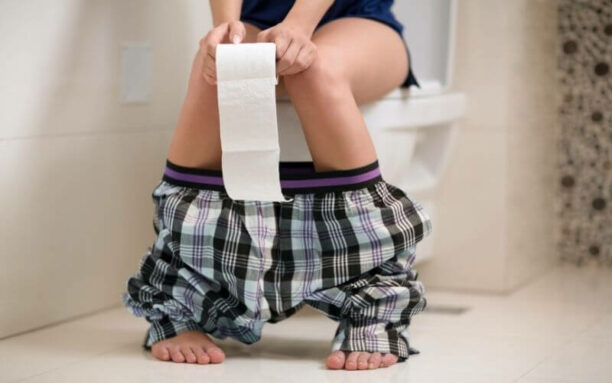What is the pelvic floor?
The pelvic floor, also known as the pelvic floor, is a set of muscles between the pelvis in the front and the coccyx at the back.
These pelvic floor muscles are used daily as they support the pelvic area and therefore the genital organs such as the bladder, uterus, and rectum.
The pelvic floor plays a crucial role because, in addition to supporting the organs, it allows for continence and is also involved in sexual well-being.
Why strengthen your pelvic floor?
The ‘pelvic floor’ is not a topic you discuss at the dinner table. It’s oonly during pregnancy or postpartum that woemn discover their pelvic floor.
However, like any other muscle in the body, it is important to take care of it. It needs to be maintained, especially to maintain its tone so that it continues to fulfill its physiological role.
Regularly exercising your pelvic floor is essential, and this, at any age of a woman’s life!
The consequences of a weakened pelvic floor
When the pelvic floor is not regularly exercised, the pelvic muscles tend to relax. If they become too relaxed, this can lead to discomforts such as urinary leaks, or more serious problems like incontinence.
If the pelvic floor is too relaxed, some women may even develop pelvic organ prolapse. In the most severe cases of prolapse, one or more organs literally come out through the vulva and end up outside the body.
Strenghthen your pelvic floor to prevent incontinence risks
Contrary to popular belief, the risk of incontinence, whether urinary or fecal, can affect any woman at any age.
The most common type of incontinence in the female population is stress urinary incontinence. Leaks occur during a physical effort, for example during:
- Coughing or sneezing
- Physical activity or exercise
- Picking up something heavy
Continuing pelvic floor rehabilitation throughout one’s life is important. This helps maintain a toned pelvic floor to prevent and limit the risk of urinary leaks.
Strengthen your pelvic floor to boost your sex life
Strengthening your pelvic floor is also important to thrive in your sexuality and intimate relationships. Indeed, a stronger pelvic floor allows :
- Better sensations during intercourse for both partners
- To have more intense and more frequent orgasms
- Improve the natural lubrufication of your pelvic floor.
The pelvic floor plays an essential role in sexual life. Many women have noticed an improvement in their sexual intercourse when the pelvic flooris stronger. A toned pelvic floor enhances clitoral stimulation and therefore, allows for better sensations.
Moreover, with more intense vaginal contractions, the vagina is tighter, which means an improvement in sensations both for you and your partner!
A toned pelvic floor to prevent aches and pains
The pelvic floor can be the cause of various aches and pains, but the link between these pains and the pelvic floor is not always obvious.
The appearance of pains is often multi-factorial. To minimize their occurrence, it is essential to strengthen your pelvic floor
In any case, if you experience this type of pain in your daily life, consult your doctor or gynecologist who can assist you.
Pelvic floor and back pain
A good posture helps protect the organs of the pelvis that rest on the pelvic floor. If you have poor posture, the pressure on these organs can lead to complications for the pelvic floor in the long term.
Pelvic pains
Pelvic pains correspond to pains located in the area below the abdomen and between the pelvic bones. Whatever the cause of the pain, pelvic floor rehabilitation can be a solution to treat these aches.
Pain during sex
Through relaxation techniques, pelvic floor rehabilitation can help reduce pain experienced during sexual intercourse. Some exercises help better understand when and how to contract and release the pelvic floor during penetration.
Pelvic floor and back pain
A good posture helps protect the organs of the pelvis that rest on the pelvic floor. If you have poor posture, the pressure on these organs can lead to complications for the pelvic floor in the long term.
Pelvic pains
Pelvic pains correspond to pains located in the area below the abdomen and between the pelvic bones. Whatever the cause of the pain, pelvic floor rehabilitation can be a solution to treat these aches.
Pain during sex
Through relaxation techniques, pelvic floor rehabilitation can help reduce pain experienced during sexual intercourse. Some exercises help better understand when and how to contract and release the pelvic floor during penetration.
A pelvic floor that relaxes and strengthens (again)!
Throughout their lives, women are exposed to factors that can worsen the condition of their pelvic floor such as :
- Preganancy and ageing
- Age realted muscle tissue changes
- Hosmonal chnages caused by menopause
- Practising certain sports….
Furthermore, many everyday activities also impact and weaken the pelvic floor
So even if you do not experience urinary leakage or pain problems, it is important to regularly strengthen your pelvic floor as a preventive measure.
Why strengthen your pelvic floor after childbirth?
The pelvic floor is heavilyimpacted during pregnancy and especially during childbirth. It is often at this moment that women become aware of their pelvic floor for the first time.
During the 9 months of pregnancy, the pelvic floor muscles have to support the weight of the baby and the intense strains related to its passage during a vaginal delivery.
Subsequently, some women experience discomfort symptoms, which can manifest as some urinary leaks, a feeling of heaviness, or even a lack of sensations during intimate relationships.
These symptoms are due to pelvic floor relaxation. Strengthening your pelvic floor then becomes essential to regain its initial tone. Even after a cesarean section, strengthening your pelvic floor is important because the baby’s weight may have damaged the pelvic floor muscles.
The pelvic floor is heavilyimpacted during pregnancy and especially during childbirth. It is often at this moment that women become aware of their pelvic floor for the first time.
During the 9 months of pregnancy, the pelvic floor muscles have to support the weight of the baby and the intense strains related to its passage during a vaginal delivery.
Subsequently, some women experience discomfort symptoms, which can manifest as some urinary leaks, a feeling of heaviness, or even a lack of sensations during intimate relationships.
These symptoms are due to pelvic floor relaxation. Strengthening your pelvic floor then becomes essential to regain its initial tone. Even after a cesarean section, strengthening your pelvic floor is important because the baby’s weight may have damaged the pelvic floor muscles.
Toning your pelvic floor during menopause
We often talk about pelvic floor rehabilitation after childbirth. In reality, it is possible to do pelvic floor rehabilitation to strengthen your pelvic floor throughout your life.
And the sessions can be very useful, especially at the onset of menopause! Since, menopause is accompanied by a major hormonal changes.
Menopause has many impacts on women’s bodies:
- Hot flashes
- Joint pain
- tIntimacy issues
- Urinary or fecal incontinence
- Vaginal dryness…
Some of these issues are related to the relaxation of the pelvic muscles. During menopause, tissues lose their elasticity and muscular capacity.
The pelvic floor can no longer properly fulfill its major role of supporting the genital organs.
Strengthening your pelvic floor is important to regain good tone. A toned pelvic floor allows preventing urinary leaks or the onset of organ descent. Moreover, it also helps to improve sensations during intimate relationships. There is no age limit to tone your pelvic floor!
We often talk about pelvic floor rehabilitation after childbirth. In reality, it is possible to do pelvic floor rehabilitation to strengthen your pelvic floor throughout your life.
And the sessions can be very useful, especially at the onset of menopause! Since, menopause is accompanied by a major hormonal changes.
Menopause has many impacts on women’s bodies:
- Hot flashes
- Joint pain
- tIntimacy issues
- Urinary or fecal incontinence
- Vaginal dryness…
Some of these issues are related to the relaxation of the pelvic muscles. During menopause, tissues lose their elasticity and muscular capacity.
The pelvic floor can no longer properly fulfill its major role of supporting the genital organs.
Strengthening your pelvic floor is important to regain good tone. A toned pelvic floor allows preventing urinary leaks or the onset of organ descent. Moreover, it also helps to improve sensations during intimate relationships. There is no age limit to tone your pelvic floor!
How to strengthen your pelvic floor?
Many approaches are available to you to strengthen your pelvic floor. With or without accessories, here are the most commonly used methods to strengthen the pelvic floor.
Avoid the stop-and-start urination technique
The stop-and-start urination technique has long been recommended to strengthen the pelvic floor, it is now completely discouraged. It disrupts the neurological functioning of the bladder.
You can use the stop-and-start urination technique but sparingly, to help you locate your pelvic floor and learn to contract it correctly. It is absolutely not recommended to regularly practice the stop-and-start urination technique as it affects the closure reflex of the sphincters.
Learning to Contract Your Pelvic floor
To properly contract your pelvic floor, you should have the sensation of “holding back a stream of urine”. This should be done without squeezing your buttocks or contracting your thighs.
Be careful, if you push, you are not contracting your pelvic floor correctly. When you go to the toilet, you should not rush and not contract the pelvic floor but instead relax it.
The ideal is to learn to contract your pelvic floorwith a healthcare professional such as a physical therapist, midwife, or gynecologist. They can ensure that the perineal contraction is correct and that no other muscle is engaged.
Doing Exercises to Strengthen Your pelvic floor
Repeat the Exercises Learned in the Clinic
To train your pelvic floor at home, you just need to repeat the exercises you learned from the physical therapist or midwife, by doing exercises yourself, contracting and relaxing your pelvic floor.
Follow Exercises on Video
Many video resources are also available online to guide you in your exercises, such as for example this video from the very famous sports coach Lucile Woodward.
Train with a Ball
To strengthen your pelvic floor, you can also use a ball. Lie on your back, knees bent, and place a ball between your knees. The exercise involves squeezing the ball with your knees. Exhale when you squeeze your knees and contract your pelvic floor at that moment. Also remember to contract your abdominal muscles.
Repeat the Exercises Learned in the Clinic
To train your pelvic floor at home, you just need to repeat the exercises you learned from the physical therapist or midwife, by doing exercises yourself, contracting and relaxing your pelvic floor.
Follow Exercises on Video
Many video resources are also available online to guide you in your exercises, such as for example this video from the very famous sports coach Lucile Woodward.
Train with a Ball
To strengthen your pelvic floor, you can also use a ball. Lie on your back, knees bent, and place a ball between your knees. The exercise involves squeezing the ball with your knees. Exhale when you squeeze your knees and contract your pelvic floor at that moment. Also remember to contract your abdominal muscles.
















